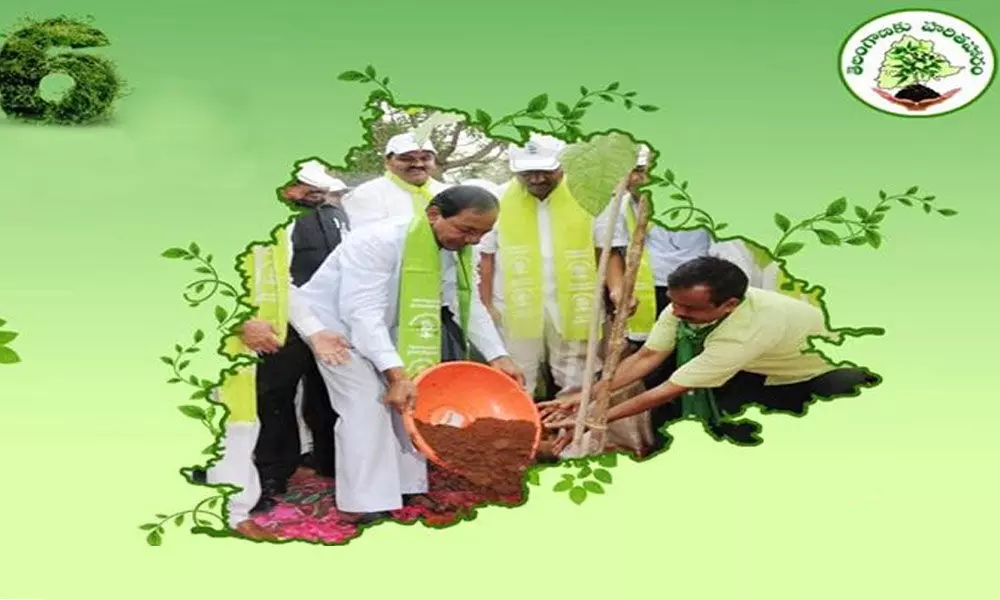Telangana government adopting innovative, inclusive green practices

Telangana government adopting innovative, inclusive green practices
The recent devastating spread of pandemic coupled with biodiversity loss and climate change has reminded mankind to introspect its broken linkages with nature
The recent devastating spread of pandemic coupled with biodiversity loss and climate change has reminded mankind to introspect its broken linkages with nature. The physical and mental well-being and capacity to counter the climate change challenges is therefore closely associated with the health of nature.
As per the 2011 census, though the urban population of Telangana is 1.36 crore (38.9 per cent) it has grown by 38.12 per cent in comparison to the rural population growth of 2.13 per cent indicating the prevalence of very high rural-to-urban migration. An increase in the number of panchayats in the state from 8846 (2014) to 12768 (2021) is also testimony to this rapid pace of urbanisation. Coupled with burgeoning needs of development and individual greed, this has same time resulted in depletion and degradation of natural resources like tree cover, water bodies, community land etc at a greater pace.
For a civilised society, protecting nature either by preventing it from being destroyed or by way of bringing it back to cities and towns is the need of the hour for overall sustainability. This has necessitated the need of exploring various mechanisms to manage existing nature and also to replenish the damaged environmental resources.
As climate change is one of the major drivers of degradation of natural resources, environmentalists and foresters advocate tree planting as well as rejuvenation approaches as low-cost, easy to adopt and a high-impact intervention to restore nature and rejuvenate degraded forests and biodiversity and sequester carbon as well.
Acknowledging the multifarious role of environmental conservation including the green cover, Telangana Government launched Telangana Ku Haritha Haram (Green Garland to Telangana) in 2015 as one of the flagship programmes. The main object of the programme was bringing green cover from 24 per cent to 33 per cent duly formulating strategies to tackle the challenges of environmental conservation and protection with the participation of all active stakeholders.
As creating green space outside notified forest area warrants active participation of people for the success of environmental conservation, an enabling environment was created by the state of Telangana for the first time by bringing historic amendments to existing Panchayat and Municipal acts. These policy changes ensured active roles and responsibilities among panchayats and municipalities for planting and protection of trees, their survival (85 per cent) and provision for the green fund thus reflecting strong political will with care and concern for the much-neglected sector of the environment.
The recently adopted approach of integrated development of villages and urban areas of the state under the banner of Palle Pragathi (Village Development ) and Pattana Pragathi (Town Development ) respectively now has become an excellent platform to fulfil the much-needed demand of environmental conservation including tree planting as one of the major components.
The core concept behind this inclusive approach of Palle Pragathi and Pattana Pragathi is to take up the developmental activities in the areas of health, sanitation, waste management, energy conservation, community infrastructure, environmental conservation including tree planting and environmental awareness duly involving all stakeholders for effective participation.
To increase green cover in all 12769 gram panchayats of the state, mini-park–cum-forests (Prukriti Vanams) are being developed in each village depending upon the availability of lands to ensure the green cover availability for villagers. Besides planting trees in blanks lands various institutions like schools, colleges, government offices, houses of individuals including agricultural lands are being taken up for planting.
Adding more strength to the ongoing mission of increasing greenery in villages, the government has recently decided to develop Bruhat Palle Prikriti Vanam (BPPV) in all the 540 mandals of the state. Spreading over nearly 10 acres of land, the major activity under Brihad Palle Prukriti Vanam is to take up tree planting under Yadadri Model (Modified Miyawaki method).
One of the major environmental concerns in the urbanized world is the degraded environmental conditions affecting the health and psychological well being of citizens which are getting impaired day by day. To meet this challenge of degrading the environment, the Government has identified 109 locations across the state for developing urban parks covering 30377 hectares.
Fulfilling the long term goals of climate resilience and ecosystem services to citizens, 53 urban parks are completed and opened for the public. The remaining 56 urban parks are getting much focus for their development and priority under the ongoing "Pattana Pragathi" programme. Ultimately with these interventions, these urban parks are turning into excellent nature-based solutions for counteracting the challenges of climate change and other benefits to the citizen. The participation of active stakeholders under the Pattana Pragathi is helping to bring much-needed resiliency and sustainability to our cities.
The specific approaches and interventions of the government are generating opportunities for the urban and village communities not only to develop green spaces but also to protect and maintain the natural environment of the local area. Further various initiatives in the area of health, sanitation and employment generation under integrated manner are helping the communities to connect with nature and assisting them to fulfill a range of social, psychological, economic and environmental benefits.
The innovative and inclusive approaches of Palle Pragathi and Pattana Pragathi are bringing the development and the environment together to ensure a balanced and sustainable model of village and urban development which is worth emulating model of development of the Telangana government. It is expected that this model of partnership with people will usher in a new era of equitable socio-economic development with environmental conservation for the benefits of all including posterity.
(The author is a senior IFS officer in Hyderabad. Views are personal)

















